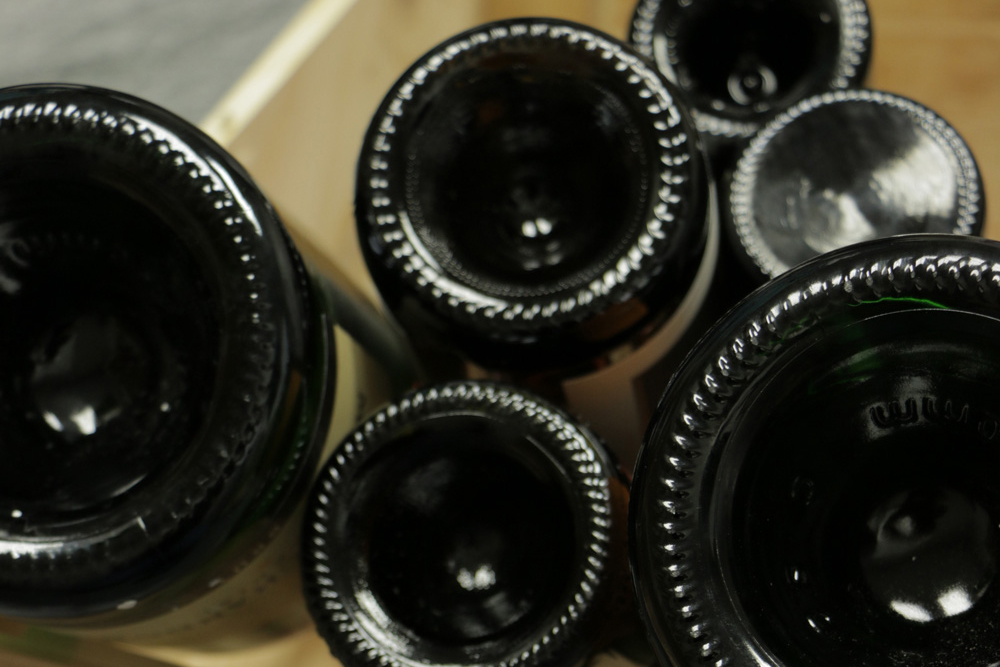Ever wonder why wine bottles are different shapes? Or why some magnum wine bottles cost more than two standard-sized bottles? We’re here to help – this post will explain: the anatomy of a wine bottle, the closure, and common wine bottle shapes and sizes.

Wine Bottle Closures
There are several types of closures used to seal wine bottles shut. Cork closures have been the traditional choice since they expose wine to a very small amount of oxygen, thereby allowing it to breathe while maturing in bottle. There is a slight chance that wines under cork may be afflicted with cork-taint, which is caused by the chemical Trichloroanisole (TCA). Cork-taint occurs during the winemaking process and has nothing to do with the wine’s provenance.
Synthetic corks, made from plastic or rubber, are generally used to close inexpensive wines. Screw caps are easy to open and provide wineries with a cost-effective alternative to cork. It is a common misconception that all wines under screw cap are of lower quality and unable to age well. Some modern versions even allow wines to breathe as they mature, similar to cork. You can also be certain that a wine under screw cap will not suffer from cork-taint. Occasionally, you may find a wine sealed with a glass stopper. These bottles are fun, not only for their novelty, but also because of the ease with which they can be opened and resealed, similar to screw caps.
Three Common Wine Bottle Shapes

Bordeaux-shaped bottles are cylindrical, with a rounded shoulder below the neck. They may have been designed in order to pour wine while catching sediment in the shoulder. Left- and right-bank Bordeaux, Tuscan reds, and New World Cabernet Sauvignon are commonly found in this type of bottle.
Germanic-shaped bottles have an even steeper slope than the Burgundy shape. The tall, sleek, columnar-figure of these bottles makes them easy to identify. This design might have traditionally given ships with limited space the ability to store large quantities of bottles in their hulls. They usually hold white wines from Germany and the Alsace region of France, Austrian wines, and New World Riesling and Gewürztraminer.
Burgundy-shaped bottles have a wider base than the Bordeaux shape, along with a steeper slope from the shoulder to the neck. They are also slightly shorter in height. This design likely became popular because of the ease with which it can be produced. Burgundy-shaped bottles can contain an array of wine types, including white and red Burgundy, Champagne, white and red Rhône wines, and New World Pinot Noir, Chardonnay, Syrah, and Grenache.

Bottle Size Names (from small to large-format)
187 ml – Split: a quarter of a standard sized bottle.
375 ml – Half-bottle: while hard to find, are often released for higher priced wines.
750 ml – Standard Size: recognized throughout the world as the standard size for a bottle of wine.
1.5 L – Magnum: equal to two standard-sized bottles.
3 L – Double Magnum: equal to two Magnum bottles. If the bottle is Burgundy-shaped it is referred to as a ‘Jeroboam.’
4.5 L – Jeroboam: equivalent to 6 standard sized bottles. While it may seem confusing, since it holds the same name as a Burgundy-shaped Double Magnum, the Burgundy-shaped 4.5 L is referred to Rehoboam, proving the importance of knowing the bottle shapes discussed above.
6 L – Imperial Magnum, or Methuselah for Champagne: holds 6000 ml, which is equivalent to 8 standard sized bottles.
9 L – Salmanazar: holds 9000 ml, which is equivalent to 12 standard bottles.
12 L – Balthazar: holds 12,000 ml, which is equivalent to 16 standard bottles.
15 L – Nebuchadnezzar: holds 15,000 ml, which is equivalent to 20 standard bottles.
As you can see, wine bottles come in a large selection of sizes. The standard-sized bottle is 750.00 ml – a format in which almost all wines are sold. Splits and half-bottles are convenient for a glass or two, and often give you an opportunity to taste higher-priced wines for less than buying a standard-sized bottle. They also take up less room in the cellar!
You can easily find large commercial brands of inexpensive wine in Magnum or large-format bottles at your local store, but these tend to focus on quantity over quality, as opposed to finer examples, valued for both their rarity and ability to age. This collectible category of Magnum and large-format bottles generally comes with a higher price tag than two or more standard-sized bottles, because the emphasis is not on the bargain, but rather on excellent quality, and the prestige associated with owning and drinking them. They also impress on a purely aesthetic level, and will enhance any special dinner or celebration.
Now, with a better understanding about the variety of different wine bottles and their anatomy, you’ll have a more complete appreciation for the world of wine.



